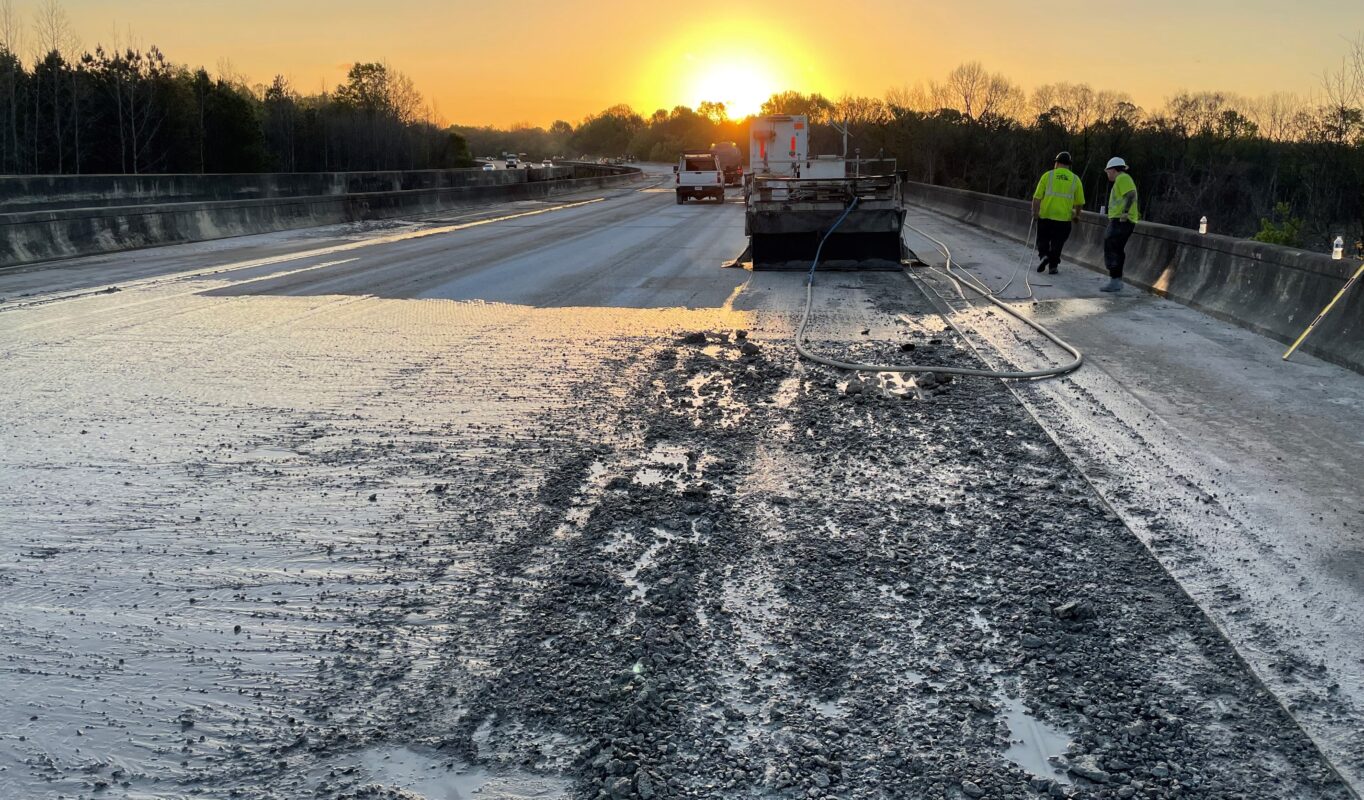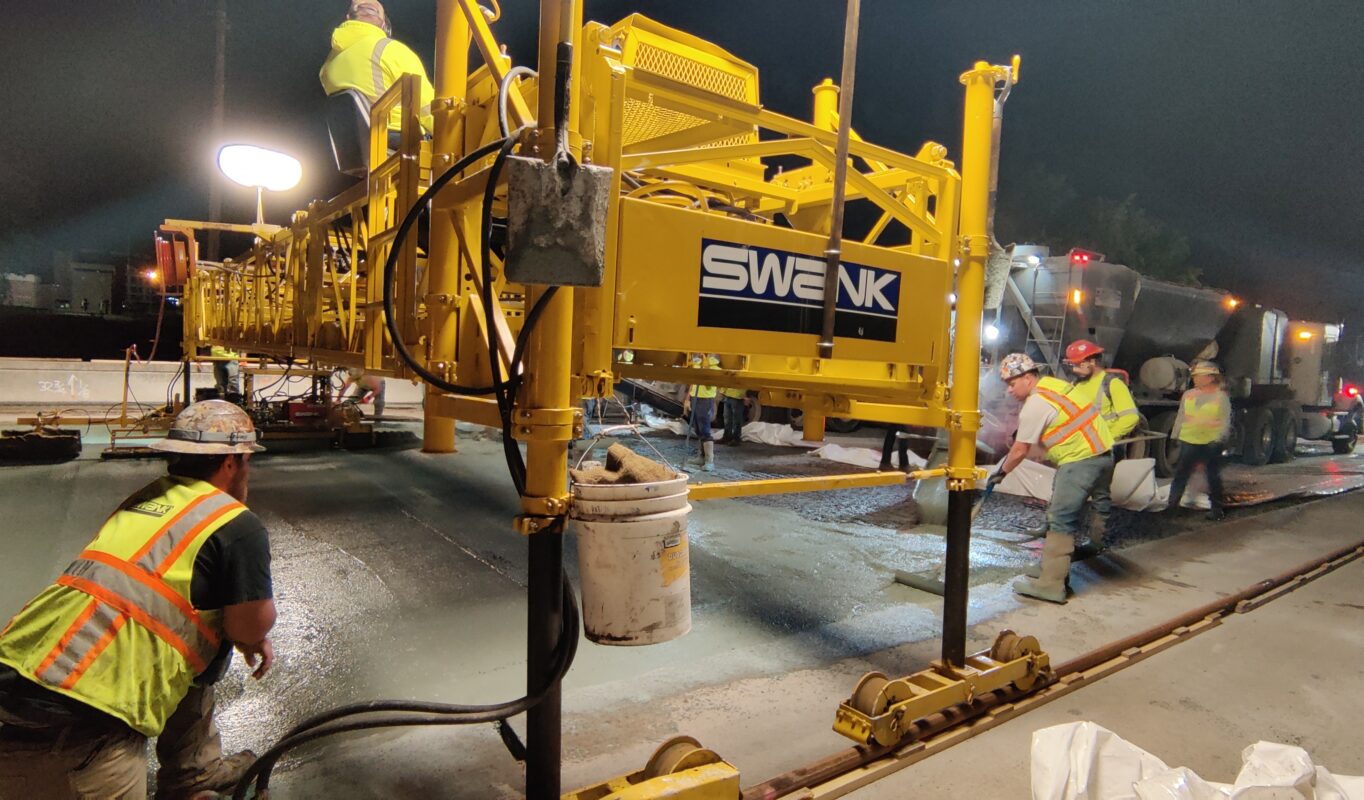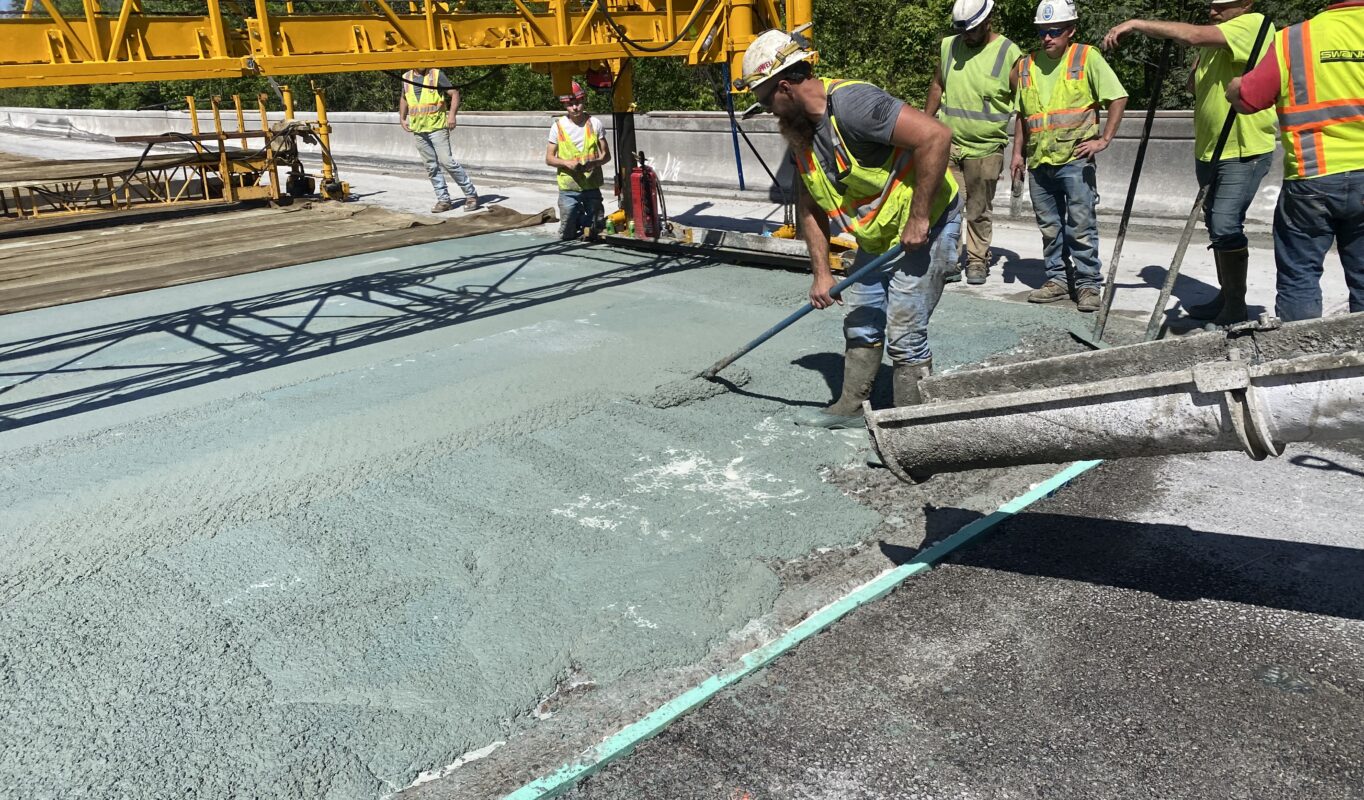As a vital highway for commercial freight and commuter traffic, I-77 extends 91 miles through South Carolina and connects the Port of Charleston to major trucking routes in neighboring states.
With an increase in the port’s cargo volume from year to year, it is vital for the interstate to be functional with minimal disruptions to traffic flow. To proactively extend the lifespan of critical infrastructure, the South Carolina Department of Transportation (SCDOT) identified 17 bridges along the corridor that would benefit from rehabilitation.
Following the previous successful replacement of the I-77 southbound deck over the Catawba River in Rock Hill, which required a 17-day closure and intensive, around-the-clock work to complete the full deck replacement, SCDOT decided to implement a similar strategy for this initiative. The project was divided into two construction phases: first, shutting down I-77 northbound, followed by a closure of I-77 southbound, each for a maximum of nine days. This approach would allow the department to simultaneously rehabilitate all 17 bridges, ensuring efficient repairs and minimizing disruptions across the corridor. Given the urgent nature of the project and with steep consequences tied to the endeavor, SCDOT selected inspectors by name from throughout the state. Due to our team’s extensive exposure to similar interstate shutdowns, KCI was selected to provide construction engineering and inspection (CEI) services for the duration of the project.
Through early coordination meetings with SCDOT, a comprehensive plan was developed to ensure the smooth execution of the project. Inspectors from multiple firms were trained in hydro-demolition and latex-modified concrete overlay installation. They were also briefed on their specific duties, testing and documentation requirements, and the collaboration process between staff and contractors. To maintain a continuous workflow, the inspection crew was divided into two shifts, with each inspector and their counterpart assigned responsibility for a single bridge. This strategic approach ensured that the project progressed efficiently, with clear roles and responsibilities established from the outset.
With traffic control in place, the team was able to begin phase one of the project. The first task was to remove the top layer of concrete using the milling method. This technique employs a specialized machine equipped with a rotating drum fitted with cutting tools, enabling a controlled and effective removal of large volumes of material. Prior to milling, the team used ground penetrating radar (GPR) to assess the depth of the concrete layer and identify the location of the rebar beneath. By milling as close as possible to the rebar, the team aimed to minimize the need for hydro-demolition, which is a more labor-intensive and water-heavy process for removing deeper layers of concrete. However, challenges arose when the GPR data led to overconfidence regarding rebar placement, resulting in some damage to the rebar during milling. To remedy this, inspection crews followed behind, inspecting what remained for damage and marking the locations that required replacement. To address the remaining unsound bridge deck concrete and failing patches, crews employed hydro-demolition. This advanced technique uses high-pressure water to precisely remove weakened or deteriorated concrete while leaving intact and structurally sound material unaffected.
 To make necessary renovations on each bridge deck, the existing concrete needed to be removed through a variety of methods. The combination of milling and hydro-demolition offers a balanced solution for material removal and surface preparation. (Image courtesy of SCDOT)
To make necessary renovations on each bridge deck, the existing concrete needed to be removed through a variety of methods. The combination of milling and hydro-demolition offers a balanced solution for material removal and surface preparation. (Image courtesy of SCDOT)Inspectors were responsible for ensuring that at least 1.5 inches of concrete had been removed as required and then carefully checked the entire area with a chain sounding test. This technique helps inspectors pinpoint areas of weak or deteriorated concrete that need further removal or repair by dragging a chain across the surface of the concrete and listening to the sound it makes. Solid, intact concrete produces a clear, ringing sound, while damaged areas produce a dull or hollow sound. When defective concrete was found, the contractor performed hand demolition by use of pneumatic breakers to remove the unsound material, followed by a re-check of the area.
With demolition of several bridges complete and others underway, preparations for pouring the new riding surfaces began. The contractor brought in concrete roller pavers, pre-assembled to match the width of the bridge deck replacement. Screed rails, guides that control the alignment of the deck screed and which the drive wheels turn on, were installed for the median side vertical support legs on wooden runners nailed to the inside shoulder. The outside support legs rode on non-powered tires directly on the bridge deck that had to be manually adjusted to maintain the screed alignment on one side. After towing the pavers to the site and placing them on the rails, the contractor set the initial height of the screed to meet the structural requirements. A test, or dry, run along the bridge span was then conducted to check the setup and mark any adjustments that needed to be made to correct for bridge irregularities. Inspectors then reviewed the reverse run, confirming the depth and coverage. Once everything was verified, the pours could begin.
 To ensure concrete was applied at the correct thickness and evenly distributed over the rebar, the team conducted test runs along the bridge spans to check the setup and make any necessary adjustments before pouring concrete.
To ensure concrete was applied at the correct thickness and evenly distributed over the rebar, the team conducted test runs along the bridge spans to check the setup and make any necessary adjustments before pouring concrete.Mobile concrete batching trucks were used to batch the concrete as it was being placed. While the contractor’s crew spread and screeded the mix, the inspection team sampled and tested it to ensure it met SCDOT specifications. Job control and early break cylinders were also cast to monitor the concrete’s strength as it cured.
One of the most significant time-saving measures implemented for this project was the utilization of inspectors across all bridges. Whenever significant work on a bridge was completed, crews were mobilized to another structure to continue the fast pace of rehabilitation. Additionally, as delays from weather were encountered, construction staff worked tirelessly to remove old deck materials before pouring new concrete.
Once all the concrete was poured for the bridge decks and the necessary joints were fixed, the night crew was dismissed and the day inspection crew took over to finish the project on time, avoiding penalties for delays. SCDOT began testing the smoothness of the completed bridge surfaces to ensure they met the required standards. Additional diamond grinding, a process involving the use of machines to grind down the surface was required to improve their rideability profiles before the final grooving process began. Once diamond grinding and grooving were finalized on the northbound lanes, our team created a punch list and marked defects for repair on all nine northbound bridges. With all equipment removed and final clean up conducted, phase one was completed, and traffic was restored more than 25 hours ahead of schedule.
“This project set a new standard for how large-scale infrastructure projects can be executed and serves as a testament to our team’s ability to deliver solutions for complex advancements in the industry.”
– Robert Atkinson, Regional Practice Leader
A few weeks later, phase two began, and the southbound lanes of I-77 were closed to drivers. Building on lessons learned from the previous closure, adjustments were made to the inspection staff schedule and bridge assignments. As a result, work progressed more smoothly this time, with fewer milling issues, and both the contractor and inspection staff having a clearer understanding of what to expect.
The project team followed the same process of hydro-demolition, concrete overlay, and joint rehabilitation while utilizing advanced materials such as high-early-strength concrete for localized patching and complete joint rehabilitation. This allowed for an accelerated curing process and quicker strength development, ensuring work progressed efficiently and on time.
 Our team’s two-phase approach was well received by community members and shed light on the coordination during construction.
Our team’s two-phase approach was well received by community members and shed light on the coordination during construction.With the team better prepared for potential issues, the project stayed well ahead of schedule. This allowed the daytime inspection crew more time to identify and mark defects for repair. KCI also supported other inspectors in marking defects on their bridges. While the interstate was closed to the public, the inspection staff and SCDOT maintenance paid special attention to any outstanding deficiencies, including the discovery and repair of a drainage concern along the bridge approaches of Bridge 4.
After updates were made, phase two of the project, which involved rehabilitating the rest of the 17 bridges, was finished 31 hours ahead of schedule. Following final inspections and contractor oversight, the project was completed and the bridges were successfully reopened to the public.


